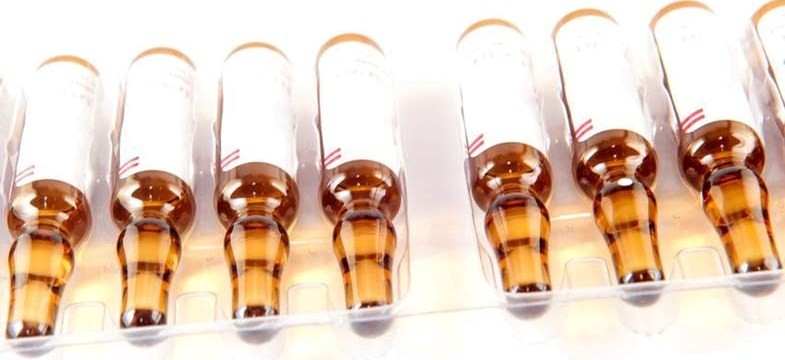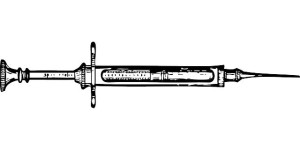Vitamin B12 Shots – Tried and Tested
Summary
|
Vitamin B12 shots are the oldest and best researched form of vitamin B12 supplements. Until as recently as a few years ago, almost all cases of vitamin B12 deficiency were treated by injection and they still play a major role today.
Since the majority of vitamin B12 deficiency diseases have something to do with absorption disorders, injections are the most reliable way of ensuring a supply of this important vitamin: the active ingredient in vitamin B12 shots goes directly into the muscle and thus finds its way into the blood without needing to take the uncertain route through the digestive tract.
After a long deficiency, vitamin B12 shots are particularly useful as they are the most reliable means of quickly replenishing the body’s B12 store and breaking the vicious circle of deficiency. Injections are therefore the method of choice for initial therapy.
Today, however, it has also been proven that in sufficient doses, oral supplements are just as effective as injections. For initial therapy, daily doses of about 5000 µg are necessary.
Vitamin B12 Ampoules – The Different Active Ingredients
Usually, there are two different vitamin B12 ampoules available, which contain two different vitamin B12 active ingredients – compared in the table below. Cyanocobalamin is an artificial form of vitamin B12 that hardly occurs in nature. Hydroxocobalamin is a natural form that is also frequently found in B12-rich foods. Both have been well researched and have proven to be very effective, but still demonstrate significant differences:
Active Ingredient | Description | Pros and Cons |
Synthetic substance, which almost never occurs naturally in nature or in the body. Broken down in the body into methylcobalamin and the poison cyanide, although the amount of cyanide is considered to be clinically irrelevant. | Very affordable and very well researched. Good tolerance and effectiveness for otherwise healthy people. Not suitable for smokers. Not suitable for detoxification purposes. | |
Hydroxocobalamin (also: Hydroxycobalamin) | Natural form of vitamin B12, produced by microorganisms and found in foods. Must be broken down by the body for use. However, this is easier and produces no by-products. Better intake and storability and can also be used as an antidote to cyanide. | Somewhat more expensive. Well researched. Good tolerance and effectiveness, better sustained release effect than cyanocobalamin, good for replenishing body’s store. Good for detoxification. Longer time period between injections required. |
Hydroxocoblamin vs Cyanocobalamin
In our opinion, hydroxocobalamin clearly has the advantage over cyanocobalamin. In numerous studies, it has been shown that hydroxocobalamin remains active in the body for much longer and is absorbed by the cells much more effectively – which is why it can be administered less frequently.
The absorption of injected hydroxocobalamin is around three times as high as that of cobalamin and the effects last considerably longer too (1-4).
Although the amount of cyanide released through cyanocobalamin injections is, clinically-speaking, completely irrelevant; the potential for even slight cyanide exposure still begs the question as to why one would select this active ingredient over the available alternative. For smokers and people suffering from diseases that relate to cyanide, cyanocobalamin shows no positive effects (5).
Hydroxocobalamin, on the other hand, has a detoxifying effect and binds not only to cyanide, but also nitric oxide. The long-term use of high doses of cyanocobalamin have also shown to leave eight times as much unusable cyanocobalamin inside the body’s cells, though the health consequences of this remain unclear (6).
When are Vitamin B12 Injections Necessary?
New research has clearly shown that the same therapeutic results provided by vitamin B12 shots can also be achieved through the long-term oral intake of vitamin B12 tablets or capsules (7).
In fact, even with a lack of intrinsic factor – the transport molecule which is essential for the absorption of B12 – the body can obtain enough vitamin B12 from oral doses via passive diffusion in the small intestine.
So, when are vitamin B12 injections really necessary?
- If the body’s vitamin B12 stores needs to be refilled quickly
- If injections at fixed intervals are preferred to taking daily capsules/tablets
- If a part of the small intestine has been removed
- If there is a severe parasite infection in the intestine
A further advantage of vitamin B12 ampoules is their purity. Typically, they contain just the active ingredient, water and sodium chloride (table salt) – and are therefore an excellent choice as an alternative to the daily intake of certain B12 tablets, which often contain harmful sweeteners, colourings and flavourings.
It is also worth consider the alternatives of vitamin B12 capsules or sprays, which tend to be the purest forms.
How are Vitamin B12 Shots Administered?
Vitamin B12 is usually injected directly into the muscle. Intravenous injections are not often practiced in vitamin B12 therapy, but are also possible – as are subcutaneous injections (under the skin), although they are somewhat unpleasant.
Of course, the application of injections carries a higher risk than taking oral supplements. If you are thinking of administering B12 injections, we strongly advise you seek a doctor’s advice beforehand. Nevertheless, similar to diabetic patients, the injection method can be properly learned under guidance from a doctor and then easily self-administered at home. It is important, however, to ensure that you adhere to the required hygiene level and dispose of the equipment properly after use. In addition to the syringe (cannula and needle), disinfectant wipes are required.
In any case, vitamin B12 shots are most commonly administered by a doctor or naturopath, since many people struggle to administer injections themselves. Plus, professionals can ensure that procedures are followed correctly.
The Risks of Vitamin B12 Injections
Vitamin B12 shots carry the same risks as all other types of injection:
- A new, clean cannula should be used and the point of injection should be disinfected with alcohol, otherwise bacterial contamination is possible. Normally, two cannulas are used: one to fill the syringe with the solution and a second for the injection
- Accidental puncturing of the small blood vessels can cause hematomas (i.e. bruises)
- Nerves or periosteum may be affected, leading to pain
- When opening the glass cannulas, minute splinters of glass can end up in the solution, which can cause organ damage in the body (8, 9)
Vitamin B12 Shots: The Correct Dosage
Vitamin B12 injections are mainly administers to rapidly refill the body’s B12 store following deficiency and to guarantee a supply for people with malabsorption and especially anemia.
Therapy takes place in two phases:
1. Initial therapy
First, a relatively large amount of B12 is injected for a few weeks in order to quickly replenish the body’s stores.
(Manufacturers recommend 6 – 10 x 1000-1500 µg/week)
2. Maintenance treatment
Then a maintenance dose is given, which ensures the daily requirement.
(Most manufacturers recommend 100 µg /month)
More general information on dosages can be found in our article: Vitamin B12 Dosages
Vitamin B12 Injections: Dosage of Various Active Ingredients
In regards to these doses, it should be added that – due to the differences mentioned above – the actual amounts of B12 absorbed differ significantly depending on the active substance:
Dose | Cyanocobalamin intake | Hydroxocobalamin intake |
1000 µg | 150 – 200 µg (15-20 %) | 700 µg (70 %) |
100 µg | 55 µg (55 %) | 70 µg (70 %) |
The difference in the long-term effect is equally major: whilst the serum levels in cyanocobalamin fall rapidly and the vitamin is excreted; hydroxocobalamin circulates in the body for a much longer time, because it binds loosely to proteins in the blood. In this way, high serum concentrations are maintained for days and weeks, providing a fairly even supply over a long period of time (10).
Based on these findings, we believe that slightly different proposals can be made for vitamin B12 treatment via injections with different active ingredients. The body’s B12 store contains around 2500 µg of the vitamin and the recommended daily allowance is 3 µg.
Taking these numbers into account, along with the findings and recommendations of current trials, the following dosages can be recommended:
Use | Cyanocobalamin | Hydroxocobalamin |
Replenishing the body’s store | 2 x 1000 µg per week for 5-8 weeks | 1000 µg per week for 4 weeks or 2 x 1000 µg per week for 1-3 weeks |
Maintenance treatment | 100 µg every 2-3 weeks or 1000 µg per month | 1000 µg every 3-6 months |
Alternative Treatment with Oral Supplements
| Use | Active Ingredient | Dosage/day | Duration |
Replenishing the body’s store | Hydroxocobalamin | 5000 µg oral | 4-6 weeks |
Additives in Vitamin B12 Ampoules
As mentioned above, B12 injections contain almost no additives. Of those that are contained, here are the most common:
Additive | Notes |
Sodium chloride | Also known as cooking or table salt, it is considered harmless, except when elevated levels of sodium or chloride in the blood occur, causing slight dehydration of the cells |
Sodium hydroxide, sodium hydroxide solution (E 524) | Considered harmless, also approved for baby foods and organic products |
Acetic acid (E 260) | Considered harmless |
Sodium acetate (E 262) | Considered harmless |
Hydrochloric acid (E 507) | Strong acid, amounts used in medicines are considered harmless, isolated cases of negative reactions |
Sodium hydrogen phosphate dihydrate (E 339) | Considered harmless, consumer protection agencies warn against consumption in large doses due to phosphorous |
Vitamin B12 Injections – Still a Good Alternative?
Given their high purity and ease of use, vitamin B12 shots are an excellent alternative to oral supplements for many people. Injections are particularly recommended in specific clinical cases of vitamin B12 deficiency because they allow for a considerably high intake.
The option of just four shots a year without needing to constantly think about vitamin B12 intake is also an attractive proposition for vegans and vegetarians. However, from a naturopathic view, shots should be an exception. A daily oral supply with low levels of B12 is much more natural, far gentler than flooding the body with high quantities of B12 at intervals.
Sources:
- Keith Boddy, Priscilla King, L. Mervyn, A. Macleod, J.F. Adams, Retention of cyanocobalamin, hydroxocobalamin, and coenzyme B12 after parenteral administration, The Lancet, Volume 292, Issue 7570, 28 September 1968, Pages 710-712, ISSN 0140-6736, http://dx.doi.org/10.1016/S0140-6736(68)90752-6.
- Glass GB, Skeggs HR, Lee DH, Jones EL, Hardy WW. Hydroxocobalamin. I. Blood levels and urinary excretion of vitamin B12 in man after a single parenteral dose of aqueous hydroxocobalamin, aqueous cyanocobalamin and cyanocobalamin zinc-tannate complex. Blood. 1961 Nov;18:511-21. PubMed PMID: 13899122.
- Begley JA, Green-Colligan PD. The availability of therapeutic hydroxocobalamin to cells. Blood. 1984 Feb;63(2):335-41. PubMed PMID: 6692038.
- Glass GBJ, et al. “Hydroxocobalamin V. Prolonged Maintenance of High Vitamin B-12 Blood Levels following a Short Course of Hydroxocobalamin Injections.” Blood, 1966, Vol. 27, No. 2, pp. 234-241.
- Hans C. Andersson, Emmanuel Shapira, Biochemical and clinical response to hydroxocobalamin versus cyanocobalamin treatment in patients with methylmalonic acidemia and homocystinuria (cblC), The Journal of Pediatrics, Volume 132, Issue 1, January 1998, Pages 121-124, ISSN 0022-3476, http://dx.doi.org/10.1016/S0022-3476(98)70496-2
- Gimsing P, Hippe E, Helleberg-Rasmussen I, et al. Cobalamin forms in plasma and tissue during treatment of vitamin B12 deficiency. Scand J Haematol 1982;29:311-318
- Andres, E., Dali-Youcef, N., Vogel, T., Serray, K. and Zimmer, J. (2009), Oral cobalamin (vitamin B12) treatment. An update. International Journal of Laboratory Hematology, 31: 1–8. doi: 10.1111/j.1751-553X.2008.01115.x
- Preston ST, Hegadoren K. Glass contamination in parenterally administered medication. J Adv Nurs. 2004 Nov;48(3):266-70. PubMed PMID: 15488040.
- Lye, S. T. and Hwang, N. C. (2003), Glass particle contamination: is it here to stay?. Anaesthesia, 58: 93–94. doi: 10.1046/j.1365-2044.2003.296812.x
- Hertz, H., Kristensen, H. P. Ø. and Hoff-JØrgensen, E. (1964), Studies on Vitamin B12 Retention Comparison of Retention Following Intramuscular Injection of Cyanocobalamin and Hydroxocobalamin. Scandinavian Journal of Haematology, 1: 5–15. doi: 10.1111/j.1600-0609.1964.tb00001.x



